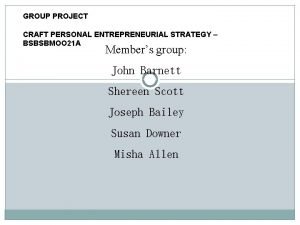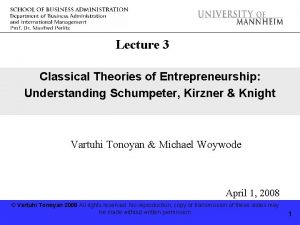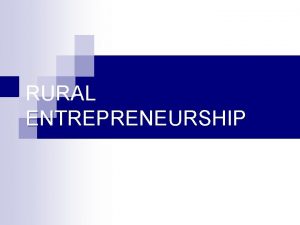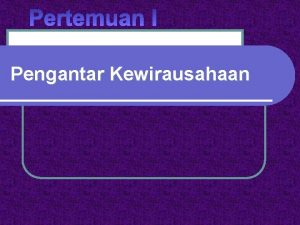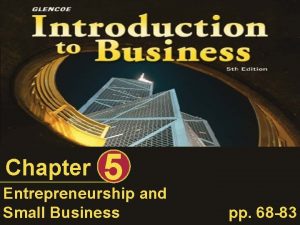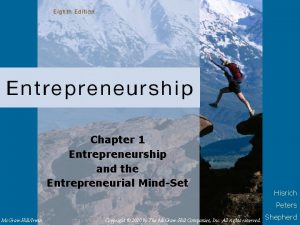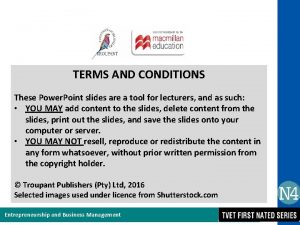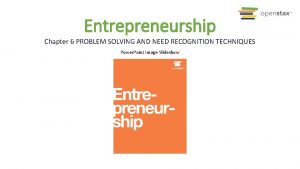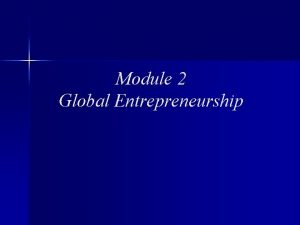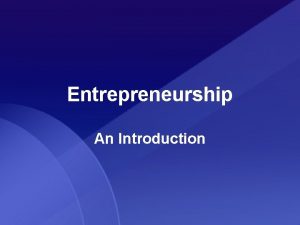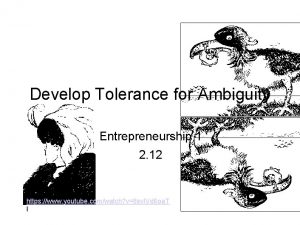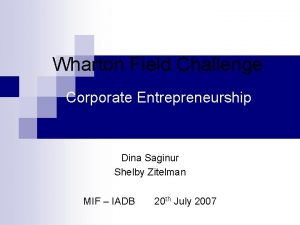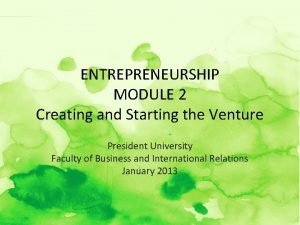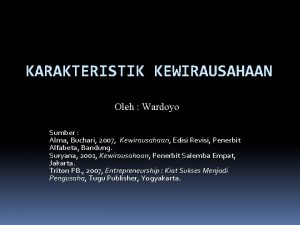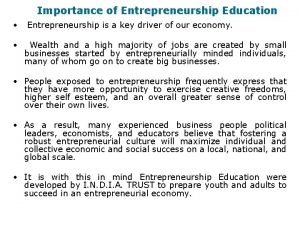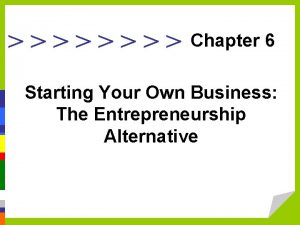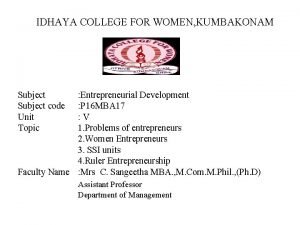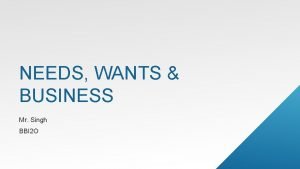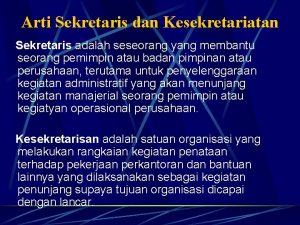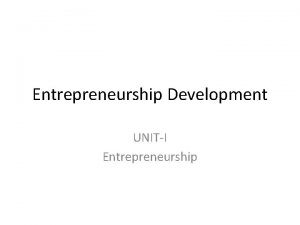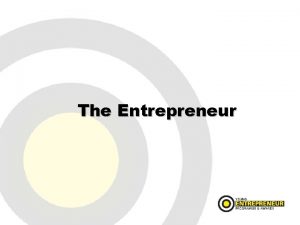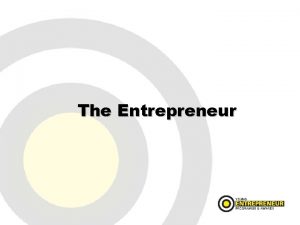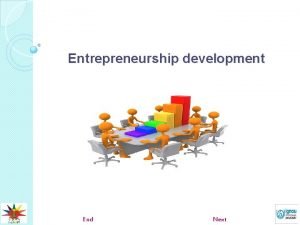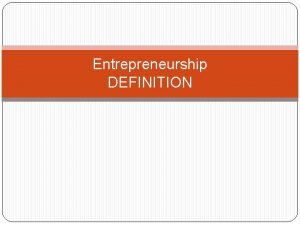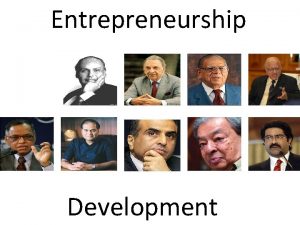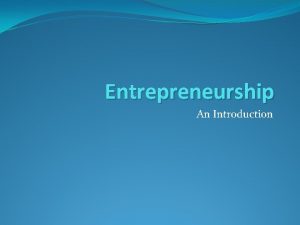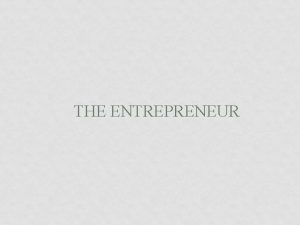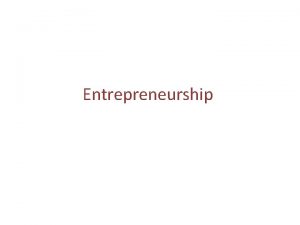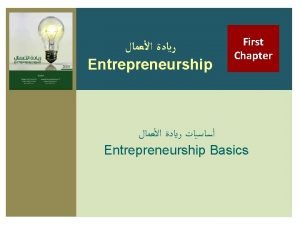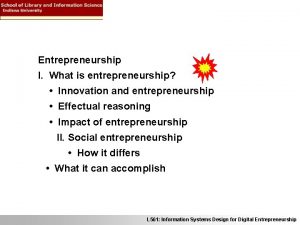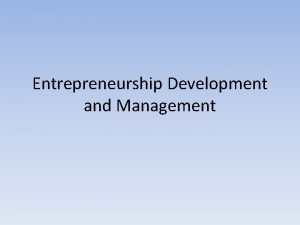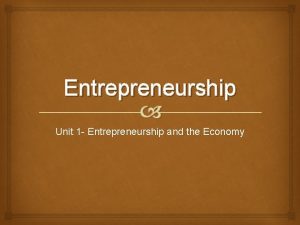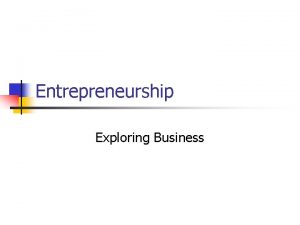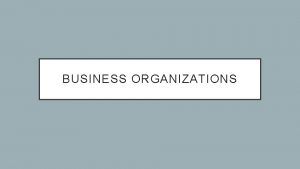Entrepreneurship Who is an Entrepreneur An entrepreneur is































- Slides: 31

Entrepreneurship

Who is an Entrepreneur? • An entrepreneur is an individual who undertakes the creation, organization, and ownership of a business.

Why Be an Entrepreneur? • Rewards – Being your own boss. – Doing something you enjoy. – Having the opportunity to be creative. – Freedom to set your own schedule. – Controlling your own salary. – Contributing to the community.

Why Be an Entrepreneur? • Costs and Risks – Work Long hours – Having an uncertain future. – Being fully responsible. – Risking one’s investment.

Characteristics of an Entrepreneur • • • Persistent Creative Responsible Inquisitive Goal-Oriented Independent

Characteristics of an Entrepreneur • • • Self-Demanding Self-Confident Risk-Taking Restless Action-Oriented Enthusiastic

Skills Needed by Entrepreneurs • Communication Skills • Human Relations Skills • Math Skills • Problem-Solving and Decision-Making Skills • Technical Skills • Basic Business Skills

Entrepreneurship in the Food Industry • Independent Restaurant- has one or more owners and is not affiliated with a national name or brand. • Chain Restaurant-has many individual restaurants that all have the same atmosphere, service, menu and quality of food. • Franchise-a franchise company sells the business owner the rights to its name, logo, concept and products. In return, the business owner agrees to run the business as outlined by the franchise company.

Entrepreneurship in the Food Industry Advantages Ownership Job Satisfaction Earning Potential • Disadvantages – Financial Risk – Competition – No Guaranteesnearly ½ of all individually owned restaurants fail within 12 months. About 85% close within the first five years.

Business Planning • A business concept is an idea for a new business that can be tested. • Answer the following questions: – What is the product or service being offered? – Who is the customer? – What is the benefit you are providing? – How will you get the product or service to the customer?

Testing the Concept in the Market • Feasibility Analysis- Process used to test a business concept. – Are there customers who want what you have to offer? – What conditions must be present for you to decide to go forward with the business?

Testing the Concept in the Market • Target Customers- the most likely the buy a product or service. • Niche- A small segment of the market. • Create a Competitive Grid- a chart that allows you to organize important information about the competition.

Competitive Grid

The Business Plan • A business plan is a document that describes a new business. It explains to lenders and investors why the new business deserves financial support. • Why Make a Business Plan? – To obtain financing. – To serve as a living guide for the business. – To provide a start-up blueprint.

The Parts of Business Plan 1. Executive Summary -a brief summary of the key points contained in a business plan. 2. Product/Service Descriptions- Present the product or service you are offering. 3. Management Team. List your qualifications and those of any partners you will have. 4. Industry/Market Analysis- Present your research into the industry and market. Analyze your customers, competition, and industry. 5. Operational Plan. Includes all of the processes that take place in the business so that the product or service is produces and delivered to the customer. 6. Organizational Plan. Looks at the people aspect of the business. 7. Marketing Plan- How a company makes it customers aware of its products or services.

The Parts of a Business Plan 8. Financial Plan -Presents the forecasts for the future of the business. Also explains the assumptions made when calculating your forecast figures. 9. Growth Plan- Looks at how the business will expand into the future.

Calculating Pricing • Break Even Point- point at which the money from product sales equals the costs of making and distributing the product.

Calculating Pricing • Markup- the amount added to the cost of an item to cover expenses and ensure a profit. Cost + markup = Price

Purchasing Management • Inventory Management – Select the right quantity – Buy the right quantity- inventory management – Timing your purchases – Choose the right vendors • Reliability • Distance • Service

Finances • Income Statement – A financial report that shows how much a business has earned or lost during a year.

Finances • Balance Sheet – A financial statement that tells you what your business is worth at any given time.

Finances • Sales Forecast – An estimate of sales for a specified period.

Finances • Variable Costs – Business expenses that change with each unit of product produced such as utilities, wages, and production materials. • Fixed Costs – Expenses that do not change with number of units produced. Example: insurance and rent.

Finances • Cash Flow Statement – A financial statement that describes the flow of cash into and out of a business.

Marketing • Promotional Mix – The combination of promotional media to reach a target market within a promotional budget. – Includes print and broadcast media.

Marketing • Five P’s of Promotion – Product-how you will design and package your product. Is it a known product or is it new and innovative? – Price- how you will price your product/service? – Place- where is your product or service sold? (web, over the phone, at a place of business) – Promotion-How promoted? Advertising, publicity, personal selling? – People- who will be responsible for marketing you product/service?

Pricing • Factors affecting Price – Costs and expenses – Supply and demand – Customer perception – Competition – Government Regulations – Technological trends

Steps in Starting a Business Idea for a new business- Business Concept. Conduct a Feasibility Analysis to see if the idea is possible.

Steps in Starting a Business Make a Prototype Create a Competitive Grid to find out about competition in the market. Determine Target Customers

Steps in Starting a Business After you conduct a Feasibility Analysis, decide whether or not the business is possible. If the idea is possible, then create a Business Plan Need a business plan when getting a loan. Need a business plan even if you have all the money you need to start a business

Review of Financial Statements • Income Statement – Shows the amount of profit or loss. • Balance Sheet – Tells what a business is worth at any given time. Includes inventory, loans, etc. • Cash Flow Statement – Shows the flow of cash into and out of a business.
 Introduction to entrepreneurship module pdf
Introduction to entrepreneurship module pdf What is agri entrepreneurship
What is agri entrepreneurship Craft personal entrepreneurial strategy
Craft personal entrepreneurial strategy Social factors affecting entrepreneurship
Social factors affecting entrepreneurship Classical theory of entrepreneurship
Classical theory of entrepreneurship Entrepreneurship and small business management chapter 1
Entrepreneurship and small business management chapter 1 Scamper technique example
Scamper technique example Types of rural entrepreneurship
Types of rural entrepreneurship Domestic entrepreneurship
Domestic entrepreneurship Secara harafiah, wira artinya...
Secara harafiah, wira artinya... Entrepreneurship robert hisrich
Entrepreneurship robert hisrich Chapter 5 entrepreneurship and small business
Chapter 5 entrepreneurship and small business Entrepreneurial cognitive adaptability
Entrepreneurial cognitive adaptability Disadvantages of entrepreneurship
Disadvantages of entrepreneurship Problem solving in entrepreneurship
Problem solving in entrepreneurship Entrepreneurship module 2
Entrepreneurship module 2 Entrepreneurship 3209
Entrepreneurship 3209 Introduction of entrepreneur
Introduction of entrepreneur Tolerance of ambiguity entrepreneur
Tolerance of ambiguity entrepreneur Entrepreneurship unit 3
Entrepreneurship unit 3 Wharton field challenge
Wharton field challenge Entrepreneurship module 2
Entrepreneurship module 2 Fabian entrepreneurship
Fabian entrepreneurship Importance of entrepreneurship
Importance of entrepreneurship Entrepreneurship chapter 6
Entrepreneurship chapter 6 Importance of women entrepreneurship
Importance of women entrepreneurship Entrepreneurship 1 final exam review
Entrepreneurship 1 final exam review Kauffman foundation entrepreneurship
Kauffman foundation entrepreneurship Needs and wants in business
Needs and wants in business Entrepreneurship artinya
Entrepreneurship artinya What are industrial estates in entrepreneurship
What are industrial estates in entrepreneurship Causes for interest in corporate entrepreneurship
Causes for interest in corporate entrepreneurship


